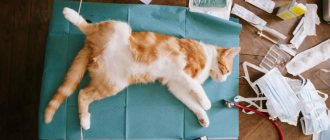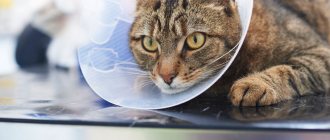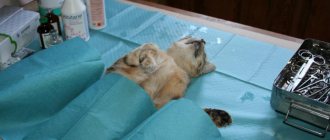What will you learn from the article?
- When to castrate a cat?
- Is it worth doing?
- How to prepare a cat for surgery?
- How does the operation take place?
- How to care for a cat after castration After local anesthesia
- After general anesthesia
- When to contact a veterinarian immediately
- Prices
By 6-8 months, cats reach sexual maturity, and the owners need to make an important decision - to castrate the cat or start looking for a bride for him. From the article you will learn what castration is, when it is performed, how to prepare a cat for it, what you need to know about this operation and the features of caring for pets after.
Castration of a cat is a surgical operation to remove the gonads from an animal.
After removing hair from the scrotum area, the doctor makes incisions, cuts off the spermatic cords, and removes the testes. The operation takes place under general anesthesia or local anesthesia.
When to castrate a cat?
At 6-12 months
According to veterinarians, the optimal age when cats can be castrated is from 6 to 12 months. At this age, the condition of the genital organs is ideal for surgery, and the influence of sex hormones on the animal is minimal. It is best to carry out the operation before the cat has time to “walk”.
What happens if you choose a different age?
If you castrate a cat too early, the animal's development may slow down. The level of sex hormones affects the rate of muscle growth. Early castrates can be smaller than their relatives and look like 10-month-old kittens until old age.
Castration too late (after 2-3 years) leads to the fact that the animal has already been formed under the influence of sex hormones and has certain habits. Therefore, after the operation the cat can continue to behave the same as before. The second disadvantage is that cats that were operated on late have a higher risk of developing obesity. Third, adult cats have a lower pain threshold, so the operation must be performed under anesthesia.
Benefits of the procedure
Castration is the only way to save a cat from suffering if he is not going to be bred and does not have the opportunity to mate regularly.
Castration is the only way to save a cat from suffering
The prejudice against surgery, which is often found among owners, is not justified.
The advantages of castration of cats are:
- preventing the development of a number of cancers;
- elimination of inflammatory processes in the cat’s reproductive system due to lack of mating;
- protecting the animal from death during the hunt in a fight with another male or due to loss of vigilance;
- eliminating the problem of cat marks appearing in the house;
- reduction of aggression in cats.
Castration in cats, like sterilization in cats, can be called a procedure that prolongs the life of pets.
Is it worth doing?
Pros:
- Change in behavior, lack of aggression;
- The cat stops marking his territory. Even if the instinct persists for some time after the operation (this is possible with late castration), the smell of urine becomes less pungent;
- The animal will not strive to leave its home - the risk that the cat will run away for a walk is reduced;
- The risk of developing malignant genital diseases is reduced several times.
Consequences (cons):
- The risk of the operation itself, performed under general anesthesia. To reduce it, do not neglect preparatory measures, carefully choose a clinic and veterinarian. Do not forget about a preliminary consultation with a veterinarian, choose modern anesthesia and procedure techniques.
- Risk of postoperative wound infection. Follow all doctor's recommendations, treat the wound, and prevent scratching and licking. If infected, contact your doctor immediately for treatment.
- Risk of pet obesity. After surgery, provide your cat with more active physical activity. Pay enough attention to your diet - reduce the serving size. After consulting with a veterinarian, switch the cat to specialized food for castrates.
Treatment for worms
Preventive treatment of pets against parasites, both external and internal, should be carried out every 3 months (at least 2 times a year). At the same time, the fight against external blood-sucking parasites, such as fleas, ticks, etc. may be needed more often when the animal spends a lot of time outside or communicates with other representatives of the animal world.
10 days before the day scheduled for surgery, it is recommended to treat the cat for helminths (if more than 1 month has passed since the last treatment). Veterinarians recommend using drugs such as Kanikquantel, Milbemax, etc.
How to prepare a cat for surgery?
The operation is dangerous for an animal with a weakened immune system, in the presence of diseases and during the recovery period. Therefore, the decision about castration surgery should be made after examination and consultation with a veterinarian. And the animal must be properly prepared for it.
Preparation for castration surgery:
- Preliminary inspection. It is carried out by a veterinarian to assess the general state of health and identify possible contraindications to the operation. As part of the examination, urine and stool samples are taken. In some cases: late castration, breed characteristics (British and Scottish cats), examination by a cardiologist, ultrasound of the heart and cardiogram will be required.
- Vaccination. The cat must have all necessary vaccinations and undergo a quarantine period (3-4 weeks).
- Anti-flea and anthelmintic treatment. 3 weeks before the proposed operation, the cat must be removed from fleas and worms.
- Anti-stress measures. In case of increased nervousness and excitability of the animal, the veterinarian prescribes sedatives 2-3 days before surgery.
- Laxatives. As prescribed by the doctor, a laxative is given 12-24 hours before surgery. So that immediately after the operation the animal does not have the urge to go to the toilet. This can negatively affect the healing of the wound and cause pain in your pet.
- Fasting and drinking regime. The animal is stopped feeding 12-16 hours before surgery. Access to water is stopped 3-4 hours before the procedure. If the cat's stomach is full, the anesthesia can cause a gag reflex - this is dangerous.
Video about preparing for surgery:
https://www.youtube.com/watch?v=88l0Q9o3nfg
Prevention of urolithiasis
The operation of castrating a cat does not provoke the development of urolithiasis, but if the owners could not avoid the animal becoming overweight, the risk of its development increases, especially in older animals, with a genetic predisposition. Manufacturers produce dry food for the prevention of urolithiasis. If your pet prefers wet food, you can choose canned food with these properties for castrated and sterilized animals of different ages, and in case of health problems, medicated food on the recommendation of a veterinarian.
In the early stages, urolithiasis does not have pronounced symptoms. It is possible to recognize it in a timely manner and begin treatment using a special cat litter, which changes color changes color when the normal pH value (more than 7.5-8) of cat urine changes, it changes color. It can be used periodically (put it in the tray once every 2-3 weeks) or regularly if the cat has a negative attitude towards changing the usual litter or requires constant monitoring of kidney function.
How does the operation take place?
The first thing a doctor does in a clinic or at home is administer anesthesia. The veterinarian selects the type of anesthesia depending on the pet’s condition after examination and its age.
- Intravenous anesthesia. The most effective and safe anesthesia. It goes away quickly and is easily tolerated.
- Intramuscular. The classic method is affordable.
- Inhalation. Expensive and complex, practically never used.
After the animal is put under anesthesia, the veterinarian removes the hair and disinfects the surgical area. A longitudinal incision is made in the scrotum area with a sterile scalpel.
The doctor removes the testis from the scrotum and ties the spermatic cord with a self-absorbing thread to prevent bleeding. After this, the testis (testicle) is excised. In a similar way, the doctor repeats the procedure for the second testis (testicle).
The wound is dried with a sterile cloth and treated with an antibiotic-based spray. In veterinary medicine, two surgical technologies are used: with self-absorbing sutures and sutureless. After the wound heals, a small scar of 1.5-2 cm remains.
Video:
Optimal age
The optimal age for castration of a cat is considered to be the period of its full maturity. In most breeds, this age occurs at 7-9 months of age. It should be clarified that especially large breeds mature a little slower (by 8-10 months), and small animals need to gain sufficient body weight.
A cat that is fully formed and its organs are functioning at full capacity reaches sexual maturity by one year. From this moment on, his testicles and pituitary gland begin to actively produce hormones that provoke sexual behavior in the pet.
But an adult cat under 7 years of age is not at risk from sterilization or castration surgery if precautions are followed. After the veterinarian’s command “prepare”, we prepare the animal in accordance with all established rules.
How to care for a cat after castration
The nature of postoperative care depends on what kind of anesthesia was used: local anesthesia or general anesthesia.
General requirements:
- After surgery, your cat will have chills. Prepare in advance a secluded, warm place to rest. Change the bedding to clean and ironed cotton fabric;
- Do not place the cat in a high place. It should be located on the floor. After surgery and anesthesia, the animal will have poor coordination of movements and may fall;
- Move the tray closer to the resting place to make it easier for the cat to get to it;
- Remove litter from the tray. The granules can injure or clog the wound. Instead of filler, you can use disposable pet diapers;
- If the cat does not go to the toilet in the litter tray, and this can happen, do not scold the animal;
- If the cat tries to lick a wound, use an Elizabethan collar.
After local anesthesia
After local anesthesia, the cat is conscious and all that is required from its owner is to treat the postoperative suture (if necessary) with special antiseptic agents, as well as thoroughly clean the litter box after each trip to the toilet. The animal may be inactive and look for a secluded place - if this lasts a short period of time after the operation, then there is no need to worry.
After general anesthesia
After general anesthesia, the cat will sleep for some time, and when it wakes up it will be weakened and disoriented. While the animal is recovering from anesthesia, it walks poorly, staggers and can easily injure itself - do not leave it unattended!
Do not force your cat to drink or forcefully offer food. The first meal can be 8-12 hours after surgery - the food should be light and in small quantities.
If your pet has a dry mouth, you can drop a couple of drops of water into the mouth to moisten the tongue. Do not force-feed copious amounts of water. The animal will drink on its own when it fully recovers from anesthesia.
When to contact a veterinarian immediately
- After castration, the pet does not eat for more than 2-3 days;
- On the first day after surgery, an increase in body temperature is observed;
- The cat has difficulty breathing, paleness or severe redness of the oral mucosa;
- Swelling has appeared.
A cat's recovery after surgery is much faster than that of a cat after sterilization. This is due to the fact that cats have a less invasive operation, i.e. requires a minimal area of intervention with a low degree of tissue trauma.
Video - care after surgery
Consequences
The consequences of the operation include complications after emasculation, predisposition to diseases, as well as changes in behavior.
Post-castration complications
During the operation, bleeding may occur, which is eliminated by the surgeon. Primary hemorrhage is less dangerous than secondary hemorrhage, which occurs suddenly, after a few hours, and can cause death from large-scale blood loss. Therefore, the animal owner needs to maintain contact with the operating veterinarian.
Hernias
Most often, the problem arises when castrating an elderly patient using the open method. But even in young cats, due to a congenital anomaly, the inguinal rings may be too wide, the vaginal membrane, the stump of the vas deferens, intestinal loops or omentum fall out. The pathology is corrected surgically.
Wound infection
The infection is caused by a cat scratching or licking the wound surface. For protection, a blanket is put on the body of the operated animal. To prevent the cat from licking itself, an Elizabethan collar is used. The cat litter box is cleaned of feces twice a day.
Predisposition to diseases
For emasculated cats, two metabolic pathologies are characteristic - urolithiasis (urothiasis), as well as obesity and its consequences.
Urolithiasis disease
The disease occurs as a result of drinking poor-quality water, but more often due to poor nutrition. Economy-grade feed, fish, and meat trimmings lead to an excess of nitrogenous components. They are toxic, and the cat’s body eliminates them in the form of sparingly soluble uric acid salts. When precipitated, stones are formed, creating obstacles to the outflow of urine. Mostly males suffer due to the tortuosity of the urethral meatus.
After emasculation, the cat's body continues to grow, but the lumen of the urethra, the development of which is influenced by androgens, remains unchanged. This is the main cause of the disease. You can prevent urotiliasis by using soft, preferably bottled, water, as well as food for castrated animals. You cannot treat your pet to fish, meat or human food.
Very fat cat
Obesity
Depriving a male of his manhood leads to hormonal modification, which negatively affects mobility. Obesity causes diseases such as:
- cardiac and renal failure;
- urothiasis;
- constipation;
- diabetes;
- arthritis;
- malignant neoplasms.
You can get rid of excess weight by limiting the amount of food, as well as by arranging active games. The apartment should have toys - “tall tree”,
"Tall tree"
House for a cat, teasers, game tracks, wind-up mice, etc.
House for a cat
Complications after surgery
The reaction to surgery is individual for each animal. After castration surgery for a kitten, the following complications are possible:
- Vomit. Typical reaction to anesthesia. If the cat vomits once and not profusely, make sure that the animal does not choke in the vomit. Turn the cat's head to the side. If vomiting is severe and uncontrollable, immediately inform the doctor who performed the operation.
- Hyperthermia. Fever, drowsiness and weakness are a normal reaction of the animal to surgery and anesthesia. This condition occurs in all cats in the first postoperative hours and can last up to 2 days. If the animal's body temperature is above 39°C and lasts more than 1-2 days after surgery, contact your veterinarian.
- Refusal to eat, lack of appetite. Fasting on the first day after surgery is normal.
- Reduced temperature. If the animal's body temperature drops below 37°C, cover it with warm heating pads. If this does not help, urgent medical attention is needed.
- Infection of a postoperative wound. Slight redness or swelling is allowed in the first 3-4 days after castration. If redness or discharge from the wound increases, you should seek help from a veterinarian.
- Inflammation of the stump of the spermatic cord. It can develop in cats in the first week after surgery. This is indicated by: lethargy, painful swelling at the operation site and an increase in the cat’s body temperature.
- Internal hemorrhage. You should be alert to: weakness and lethargy of the cat, drowsiness, pale oral mucosa (white). Each touch to the animal will cause a painful reaction in it. You cannot do without the help of a veterinarian.
- Obesity. Changes in the animal's hormonal levels after surgery cause metabolic disorders. He slows down. Possible weight gain. Do not overfeed your cat and create a balanced diet.
Important!
Stay close to your cat after surgery and contact your veterinarian if any suspicious symptoms occur.
Feeding castrated (sterilized) animals
After castration (sterilization), animals become calmer and may gain excess weight. To avoid this, you need to review your pet's diet. Consult with your veterinarian and select dry or canned food for neutered animals in your favorite flavor (chicken, beef, turkey, salmon, grain-free, etc.). Such food is available in the lines of most well-known manufacturers of cat food from economy class to holistic. Find out if your pet needs a healthy diet or a medicinal diet. It is recommended to be given in the first days after surgery for quick recovery of strength, for excess weight, and diseases of the gastrointestinal tract. There is no need to prescribe medicated food to your pet on your own.
What is the price
Russia
- Moscow and St. Petersburg – 1000 – 3000 rubles;
- Regions of Russia – 850 – 2500 rub.
Ukraine
- Kyiv – 350 – 900 hryvnia;
- Regions of Ukraine – 250 – 500 UAH;
Be careful when choosing a clinic. If a small and attractive price is indicated, it is quite possible that this is a marketing ploy with which they are trying to lure you.
A suspiciously low price for castration indicates that you may be additionally billed for anesthesia, medications and consumables. Take the time to find out everything in detail before you sign up for the operation.
Preoperative fasting
Due to the fact that cat castration surgery involves general anesthesia, the owner should deprive the cats of food for the last 12 hours. It should be recalled that for carnivores, which include all cats, fasting for 1-2 days is normal and does not harm their health.
Fasting concerns only food, there is no need to exclude water. The reasons for “forbidden” and why you cannot feed the cat lie in the fact that vomiting may occur during the operation. If the animal's stomach is not empty, it may choke on its own vomit.
Is it worth castrating a cat at home?
If you do not want to take your pet to the clinic or are unable to do so, consider having neutering surgery at home.
Features of preparing and performing surgery at home
- The animal is prepared in the same way as for an operation that is performed in a hospital setting;
- You need to prepare a clean room. A bathroom that is washed using household disinfectants, dried and ventilated is best suited. It is impossible to achieve sterility at home, but it is not necessary. Castration is not an abdominal operation;
- A table for surgical procedures is installed in the prepared room. It is also disinfected.
Pros:
- Saving time on transporting the animal to the clinic;
- The animal does not experience stress from transportation;
- After the operation, the cat is in a familiar environment, he recovers faster;
- There is no risk of infection from other animals.
Minuses:
- Inability to achieve sterility;
- There is no equipment for resuscitation measures. It may be needed if the animal has an individual negative reaction to anesthesia or medications;
- Calling a specialist to your home is more expensive and may depend on the distance of the house from the clinic.
Prices
Russia
- Moscow and St. Petersburg – 2200 – 3000 rubles;
- Regions of Russia – 1500 – 2500 rubles.
Ukraine
- Kyiv – 500 – 900 hryvnia;
- Regions of Ukraine – 400 – 500 UAH;
Description of the procedure and indications for it
Castration is carried out for cats of any breed.
Castration of cats is carried out to eliminate periods of sexual heat in animals that do not have the opportunity to mate. The procedure simplifies the life of the owners and is required for the cats themselves, since if they cannot satisfy their mating needs, they begin to suffer from mental disorders and inflammatory diseases of the genitourinary system.
Free-roaming cats during the “wedding” period, when natural instinct pushes them to search for a cat, often die because they temporarily lose their sense of danger and lose vigilance.
Veterinarians also identify mandatory indications for castration, the main of which are:
- traumatic injury to the scrotum, spermatic canal or testis itself;
- pathologies in the development of the reproductive system;
- orchitis;
- special aggressiveness of the cat during the hunting period.
Castration of cats takes place under anesthesia, which is administered intravenously. Thanks to this, the animal does not experience pain during the operation. Anesthesia is maintained for 2-3 hours after surgery.
The hair from the scrotum is removed and incisions are made in the skin and lining of the testicles. The spermatic cords are then ligated and the testicles (testes) are cut off. A suture is not applied after the procedure, as it is not necessary.
Then the cat comes out of anesthesia on its own or is removed by a veterinarian using medications. The duration of the operation itself is 10 minutes.
Important! Despite the simplicity of the operation, it must be performed by a veterinarian with experience in operating cats.
Alternative methods of castration
Modern veterinary medicine also knows other methods of castration (sterilization) of cats. They are used as an alternative to surgery, but not as often as the classic method.
- Vasectomy (sterilization). It involves ligating the vas deferens. The cat loses the ability to have offspring, but does not lose the ability to mate. The operation is complex and expensive.
- Radiation sterilization. Targeted irradiation of the cat's reproductive organs (testicles). The method is rare, expensive, and requires special high-tech equipment.
- Temporary chemical castration. An implant containing a substance that suppresses the animal’s sexual desire is inserted under the animal’s skin. Expensive way.
- Hormonal temporary sterilization. Once every six months, the animal is given a hormonal injection that suppresses sexual desire. This manipulation is carried out for life.
Important!
All methods can be used to castrate a kitten, but surgery is considered the most effective and safest today.
Whether or not to castrate your cat is up to you to decide. But remember that not only we humans should live comfortably, but also our pets for whom we are responsible.
Sterilization and castration of cats
Often, cat owners confuse two inherently different concepts: “castration” and “sterilization,” naively believing that castration is “when the bells are cut off for cats,” and sterilization is the same as castration, only in cats. Both of these procedures can be performed on both male and female cats. Neutering a cat involves either ligating the ovaries or removing the uterus while leaving the ovaries. A cat can “flow”, experience urges and still make love to the cat, however, without the threat of becoming pregnant. Well, it’s just like with people.
Castration of a cat involves removing both the uterus and ovaries. After this procedure, cats do not go into heat, hormones do not fluctuate, the risk of cancer is reduced, and the function of the ovaries is transferred to the adrenal glands.
Anesthesia
The operation is performed under general anesthesia. Veterinary clinics use the inhalation method, intramuscular and intravenous injections, and gas anesthesia for anesthesia.
The latter has no side effects, does not cause pain and does not have any side effects on the body. In addition, the supply of gas anesthesia is controlled during the period of manipulation: the concentration of the drug can simply be reduced or increased. With this type of anesthesia, your pet can be quickly brought out of this state.
The drugs used for anesthesia are determined by the doctor depending on the general health of the animal and other indicators. Under anesthesia, the cat sleeps, does not perceive pain, his consciousness is turned off and his muscles are relaxed. The selection of drugs is carried out individually in veterinary clinics. Intravenous anesthesia is considered the most effective.
The substance acts quickly and has no side effects on the heart and lungs. The intramuscular method has an affordable price and is considered traditional. Inhalation, in comparison with other methods, is more complex and expensive, and is rarely used.
Why is this needed? Pros. Cons and contraindications
Sterilization of felines is resorted to in order to stop or suspend reproductive function. The production of male hormones stops and, as a result:
- the cat stops screaming at night;
- aggressive behavior is replaced by affectionate behavior;
- The problem of territory marks and unpleasant smell in the apartment is solved.
- Veterinarians note other positive aspects of surgical intervention:
- the life expectancy of a neutered furry friend is 1.5-2 years longer;
- the search for the cat ends;
- exclusion of diseases such as adenoma, prostatitis, breast and anal gland tumors;
- the pet becomes balanced, obedient, and does not get into fights.
Among the disadvantages are laziness and a sedentary lifestyle, which results in obesity and related problems. Urolithiasis is also possible. To avoid these manifestations, you should adjust your diet. Anesthesia also carries some risk, especially for older cats. In addition, surgery may be accompanied by complications. It is important that the procedure is carried out by an experienced, qualified and responsible doctor.
Surgical manipulations for the purpose of defertility are prescribed only to healthy males. In veterinary medicine, the following contraindications are identified:
- liver, kidney failure;
- cardiovascular diseases;
- anemia;
- epilepsy;
- respiratory diseases, including bronchial asthma;
- exhaustion of the body;
- time before scheduled vaccination 14 days;
- 30 days have not passed from the date of the last vaccination.
In order to minimize risks, veterinarians do not recommend castrating cats younger than 7 months and older than 8 years.
Certain advantages of castration
When castrating an animal, there is a certain list of positive aspects. First of all, the pet is freed from the influence of hormonal storms, the kitten’s behavior becomes more peaceful and predictable. The cat now pays all his attention to his owners, plays, and does not try to chase rivals or pursue cats in heat.
Let's consider the advantages of castration:
- Reducing injuries. Sexual desire is reduced, there are fewer reasons to get involved in a fight, jump from a balcony, or wander around.
- The urge to mark territory decreases. Here we need to make a reservation: the reason for the marks may lie in the psychological motives of the animal, not related to sexual needs. The cat urinates past the tray when it wants to “win back space”, due to stress, constant attention, or vice versa – lack of communication.
- Prevention of oncology in the genitourinary area. There is no need to use drugs to suppress heat, which consist of high doses of hormones.
- Behavior correction. The animal becomes a friendly and sociable big kitten. With reduced hormones, a cat's priorities change.
- If you are not a breeder, the operation will eliminate insemination with the cat and the birth of an unplanned litter.
Castration is a serious operation, although it has been practiced by veterinarians. The need for its implementation should be carefully considered by the owner.
Possible consequences for the cat
Now let's talk about the other side of the coin. First of all, the use of anesthesia has its negative sides. You can conduct a preliminary examination of your pet if you suspect hidden chronic diseases.
If the cat is not prone to disease and there are no dangerous pathologies in the family history, then there is no particular reason to carry out diagnostics and refuse castration.
Note!
Castration does not solve literally all behavioral problems.
Although castration is presented in veterinary medicine as an everyday procedure, for a pet it is stressful and interferes with the normal functioning of the entire body. Owners must understand full responsibility for the decision made and in the future adhere to all the doctor’s recommendations so that the cat enjoys activity and health. Be prepared for the possible purchase of special food and provide the animal with conditions to expel energy - otherwise, you may end up with a pet with obesity and the ensuing problems.
Moral and physiological arguments against
The main argument of opponents of sterilization and castration is the belief that depriving animals of the opportunity to procreate is inhumane. They believe that a cat has the right to motherhood and should not be deprived of this happiness. But we should not transfer human feelings to animals and attribute our experiences to them. In addition, a cat or cat that is sterilized at an early age is completely unaware of suffering and regret. They have not experienced sexual desire and are not aware of its existence.
Some owners refuse to spay or neuter their pet for fear of harming its health. It is known that after such operations there is a real risk of obesity, diabetes, and disorders in the functions of other organs. However, there is a way to avoid such problems. To do this, you must strictly follow the rules of feeding castrated and sterilized animals. Their diet differs from the standard menu.
Advice from experts and owners
According to the advice of veterinarians, castrating a male is safe, quick and with virtually no consequences. Modern clinics offer excellent conditions for the procedure. The operation takes place within 10-15 minutes, complications are rare.
If this procedure is not carried out, the cat will mark the territory, thereby damaging the owners’ personal belongings and furniture. The way out of the situation is to send the cat for a walk outside and find the cat yourself or bring the pair home. In this case, there is a risk of a fight, as well as other negative consequences.
Owners of mustachioed pets who have undergone castration are advised to resort to the procedure. If the animal is a pet and practically never goes outside, there is no point in torturing it.
Castration for diseases
There are medical indications for which castration is vital:
- prostate cancer, other neoplasms in the genital organs;
- testicular injuries;
- urolithiasis disease;
- genetic pathologies.
Among the genetic diseases is cryptorchidism. With this disease, one or both testicles remain in the groin under the skin or in the peritoneum. In a healthy animal, the ovaries extend into the scrotum. In this case, surgery is indicated. If the procedure is not carried out, the development of testicular pathologies may occur, including saminoma - an ovarian tumor. This operation is more difficult and expensive.











